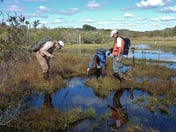 On April 30, the US Environmental Protection Agency (EPA) published a proposed rule (40 CFR part 30) to “strengthen transparency in regulatory science” by requiring the agency to make the data and models used for significant regulatory decisions available for public and peer review. Like most things regarding EPA these days, the proposal has generated significant controversy – based to a large extent to whether the commenter puts more trust in the proposed system and today’s EPA, or in the existing system and yesterday’s EPA. In the remainder of this blog I’ll discuss what’s nominally involved, and possible adjustments to narrow the opportunities for manipulation by tomorrow’s EPA.
On April 30, the US Environmental Protection Agency (EPA) published a proposed rule (40 CFR part 30) to “strengthen transparency in regulatory science” by requiring the agency to make the data and models used for significant regulatory decisions available for public and peer review. Like most things regarding EPA these days, the proposal has generated significant controversy – based to a large extent to whether the commenter puts more trust in the proposed system and today’s EPA, or in the existing system and yesterday’s EPA. In the remainder of this blog I’ll discuss what’s nominally involved, and possible adjustments to narrow the opportunities for manipulation by tomorrow’s EPA.
What is EPA’s Critique of Existing Practice?
In the explanation for its proposal, EPA argues that many significant environmental regulations are based on scientific studies – providing epidemiological information about how human and animal populations are affected by exposures to chemicals and pollutants (dose responses), driving estimates of the health and environmental benefits of enhanced regulations that are used to justify the costs of compliance – without broader access to the data and methodologies. EPA argues that external validation is critical to validation of its regulations and policies, and proposes to publicize information to allow such outsider validation.
Outside the formal rulemaking, EPA Administrator Scott Pruitt and others have argued that EPA has used uncertain and “secret science” to reach unsupportable and costly conclusions. For example, automakers and coal industry entities have argued that health and climate effects of fossil fuel use are uncertain and overstated. The same arguments have been made by political supporters of industry positions, including Congressman Lamar Smith (R-Texas) who has introduced the “Honest and Open New EPA Science Treatment Act of 2017” (“HONEST Act”) to require measures similar to those EPA is now proposing.
What is EPA Proposing?
- Which rulemakings would be affected?
EPA proposes that “[w]hen promulgating significant regulatory actions, the Agency shall ensure that dose response data and models underlying pivotal regulatory science are publicly available in a manner sufficient for independent validation.” EPA would define the key terms as follows:
***
Pivotal regulatory science means the specific scientific studies or analyses that drive the requirements and/or quantitative analysis of EPA final significant regulatory decisions.
***
The proposal would allow the Administrator to provide exemptions. The request for comments invites the public to offer changes to this proposed scope.
- How would EPA make data and models available for independent validation?
EPA’s exact plans aren’t entirely clear. The agency proposes to make these materials “publicly available in a manner sufficient for independent validation.” But it also pledges to “do so in a fashion that is consistent with law, protects privacy, confidentiality, confidential business information, and is sensitive to national and homeland security.” In doing so, the proposed rules leave room for supporters to assert that protections would be sufficient and effective. Meanwhile, opponents of this proposal (and the HONEST Act and other similar initiatives) note the lack of any specifics and argue that research would be chilled because actual assurances of individual medical privacy and/or confidential business information would not be sufficient to avoid chilling research.
Now What?
The formal rulemaking document seeks public comments by May 30, 2018. It’s possible that comments will provide specifics for protections of confidential information that EPA could incorporate into the final rules. Doing so could change the debate, which is largely about whether EPA can be trusted to increase transparency rather than to stifle innovative scientific approaches and minimize regulation.
Self-Assessment Checklist
Is the organization subject to significant regulatory actions by EPA, the benefits and costs of which are evaluated using scientific data and methodologies that are subject to adequate independent validation?
Does the organization provide technical or scientific services that can be used to generate data or methodologies useable in significant regulatory actions by EPA?
Where Do I Go For More Information?
Information available via the Internet includes:
-
EPA proposal (4/30/18 Federal Register)
-
Text of “HONEST Act”
Specialty Technical Publishers (STP) provides a variety of single-law and multi-law services, intended to facilitate clients’ understanding of and compliance with requirements. These include:
About the Author
 Jon Elliott is President of Touchstone Environmental and has been a major contributor to STP’s product range for over 25 years. He was involved in developing 13 existing products, including Environmental Compliance: A Simplified National Guide and The Complete Guide to Environmental Law.
Jon Elliott is President of Touchstone Environmental and has been a major contributor to STP’s product range for over 25 years. He was involved in developing 13 existing products, including Environmental Compliance: A Simplified National Guide and The Complete Guide to Environmental Law.
Mr. Elliott has a diverse educational background. In addition to his Juris Doctor (University of California, Boalt Hall School of Law, 1981), he holds a Master of Public Policy (Goldman School of Public Policy [GSPP], UC Berkeley, 1980), and a Bachelor of Science in Mechanical Engineering (Princeton University, 1977).
Mr. Elliott is active in professional and community organizations. In addition, he is a past chairman of the Board of Directors of the GSPP Alumni Association, and past member of the Executive Committee of the State Bar of California's Environmental Law Section (including past chair of its Legislative Committee).
You may contact Mr. Elliott directly at: tei@ix.netcom.com

